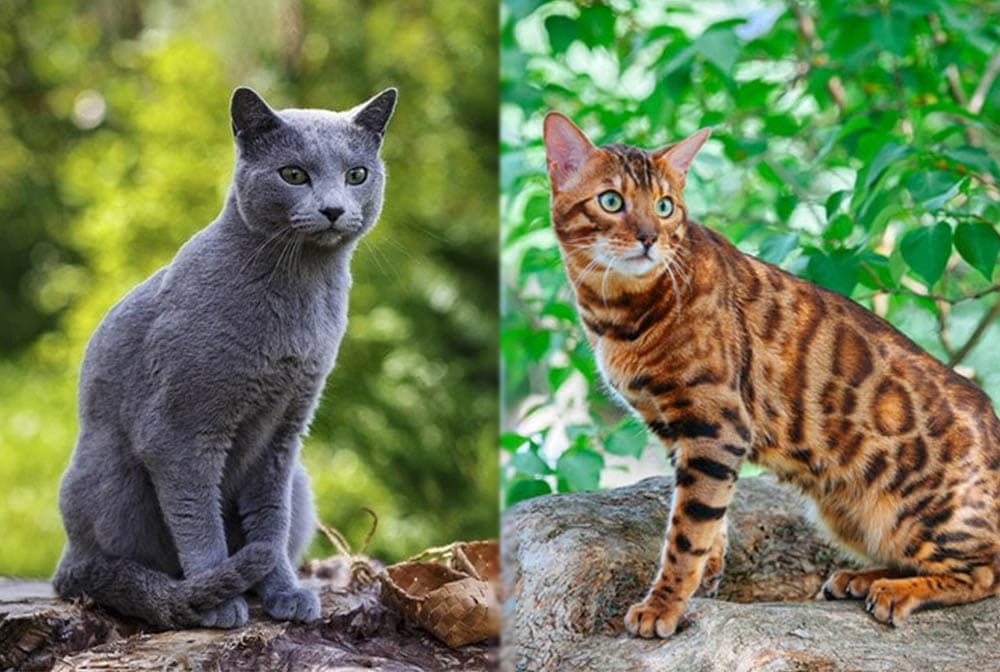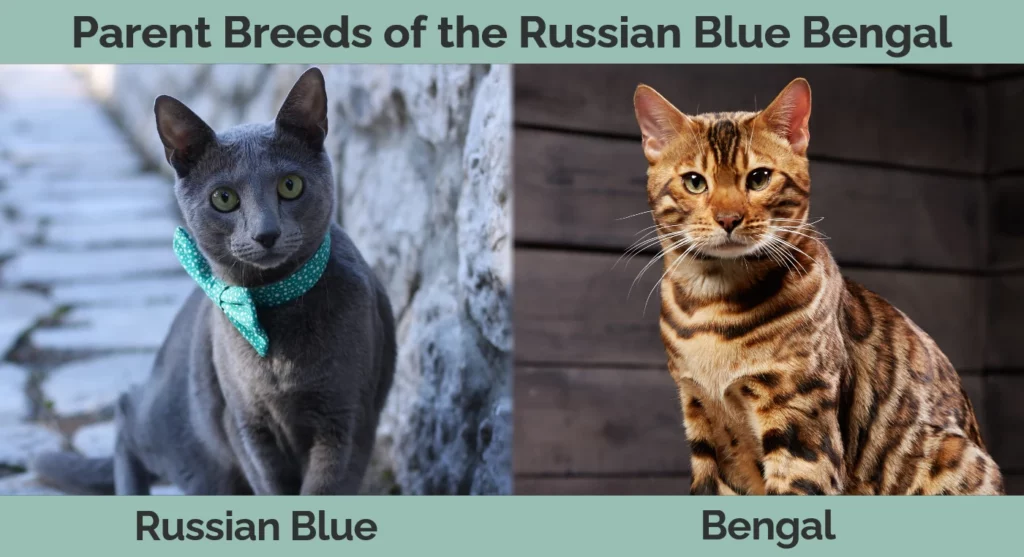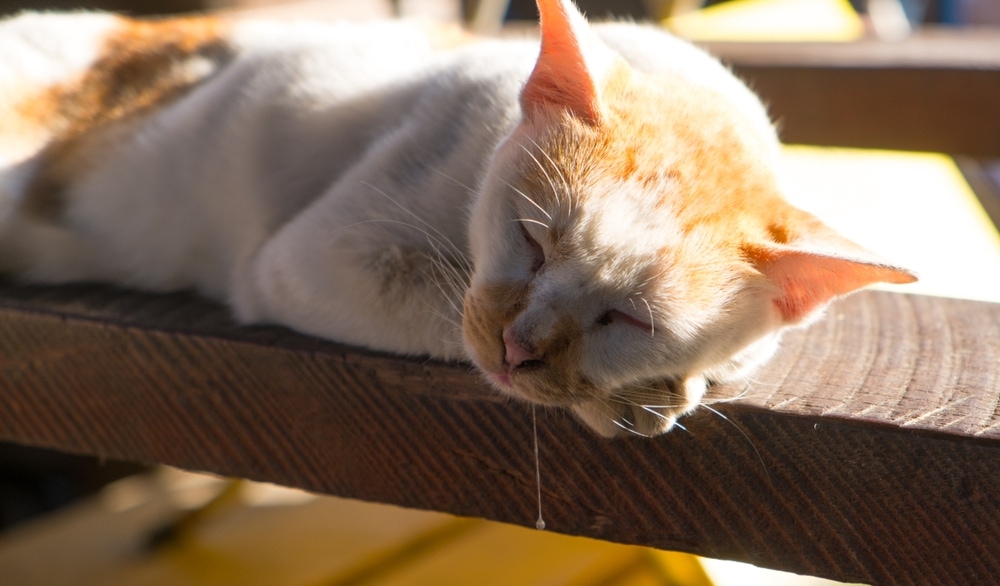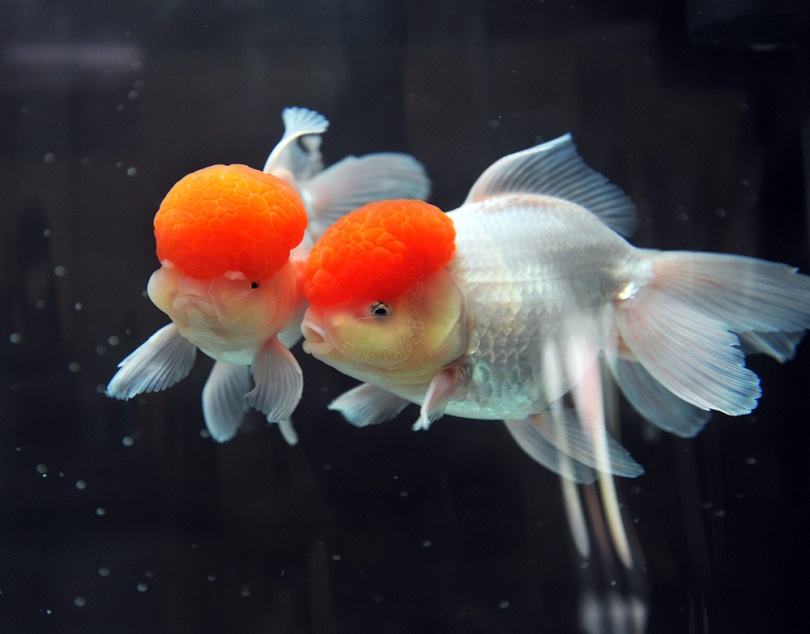Russian Blue Bengal Cat Mix: Pictures, Care, Info & Traits
Updated on

| Height: | 10–16 inches |
| Weight: | 7–15 pounds |
| Lifespan: | 12–20 years |
| Colors: | Blue, silver, brown, snow |
| Suitable for: | Active families, active older people, people willing to provide lots of time and entertainment to their cat, feline sports |
| Temperament: | Affectionate, confident, curious, playful |
The Bengal cat is a beautiful breed known for their athleticism and desire to be with people. Bengals love to climb, jump, and play, and they are pretty needy cats, often meowing or stealing items from their people to get attention. They are large cats with a stocky, muscular, athletic build.
When you combine these breeds, it’s hard to say which combination of traits you’ll end up with. Either way, you will end up with an intelligent, loving cat.
Russian Blue Bengal Cat Mix Kittens
It’s difficult to say how much you may spend on this mix because they’re rare. You’ll likely spend less on a mixed breed than you would purchasing a purebred cat, and you can check rescues and shelters for Russian Blue Bengal Kittens. With a Bengal as a parent, the kitten will likely be incredibly energetic.
3 Little-Known Facts About the Russian Blue Bengal Cat Mix
1. Russian Blue Cats Were Well-Loved by Royalty.
Russian Blue cats have a mysterious origin, but they began arriving in Europe and Asia on ships from Russia’s Archangel Island (Arkhangelsk). They rapidly became popular with Russian Czars and European royalty for their beauty and desirable temperament. The cats were so popular that they were among some of the first cats to compete in European cat shows.
2. Bengal Cats Have Wild Cat Blood.
The Bengal cat originated in the 1960s when a domestic tabby cat was crossed with an Asian Leopard cat. The original breeding was unintentional, but the breeder saw the potential for the hybrid and began working on breed development. Although the Bengal is a well-established breed today, some areas still restrict the ownership of the cats due to their wild blood.
3. The Russian Blue Bengal Cat Mix Is Likely to Be Noisy.
Although Russian Blue cats are self-sufficient, they will tell you when they want something. More often than not, this involves meowing to get your attention. The Bengal cat, on the other hand, will meow at you for any number of reasons. They love to make noise and get your attention. By combining the two breeds, you’ll likely end up with a cat that loves to tell you everything about their day by meowing.

Temperament & Intelligence of the Russian Blue Bengal Cat Mix
Are These Cats Good for Families? 👪
Since this is a mixed breed, it’s tough to say precisely what you’ll get temperament-wise. However, the Russian Blue is a well-loved family cat due to their gentle, laid-back nature. The Bengal, on the other hand, can be a bit more active and wild, with scratching and biting as part of play. With a mixture of the two breeds, you still may need to spend a significant amount of time training your cat not to bite or scratch and teaching them how to play appropriately.
Because of this uncertainty, it may be best to avoid having this mix in a home with small children. Older children will likely be fine, but they should be taught to handle the cat and respect their boundaries. Older children can help with training and reinforce good behavior for the cat.
Does This Breed Get Along with Other Pets?
The Russian Blue Bengal mix will likely get along well with other pets if proper introductions are made. Bengals are big fans of having other pets as friends, especially dogs. Coincidentally, the Russian Blue also enjoys the company of other pets, particularly dogs. Both breeds are considered “dog-like” cats.
It’s important to keep small pets, like rodents and reptiles, out of reach of your Russian Blue Bengal mix. Bengals are fantastic hunters, and their wild blood makes them more likely to injure or kill small animals than many other domestic cats.
Russian Blue cats are less interested in hunting, but they are still cats and may still go for small animals. Ideally, your cat should never come into contact with small animals in your home.
Things to Know When Owning a Russian Blue Bengal Cat Mix:
Food & Diet Requirements 🐡
It’s vital to ensure that your Russian Blue Bengal mix is on a high-quality WSAVA-compliant diet. Since both breeds have athletic bodies, the combination of the two is likely to as well, so a high-protein diet will help maintain muscle mass and healthy growth. Some vets recommend feeding cats wet food to ensure proper hydration, and a full wet food diet or a combination of wet and dry food is ideal.
While raw diets are popular, it’s necessary to discuss them with your veterinarian or a board-certified veterinary nutritionist before attempting them at home. Raw diets have risks and can be extremely difficult to balance correctly.
Exercise 🐈
If you’re bringing home a Russian Blue Bengal cat mix, get ready to work! Bengals are known for their love of activities, from climbing and jumping to going for walks on a leash and playing games like fetch. Russian Blues are less active than Bengal, but they’re far from lazy.
They love to play fetch and go for walks on a leash. You should aim to give your cat at least 30–60 minutes of exercise every day to help burn excess energy. Make sure to provide a variety of toys, scratchers, and climbing items.
Rotating through your toys and introducing new toys will help keep things interesting for your cat. If your cat becomes bored, they’re likely to start getting into trouble, so provide plenty of options for your cat to stay entertained.
Training 🧶
This is a brilliant combination of cats, so you’re likely to experience success in training your Russian Blue Bengal cat mix. Not only can these cats be trained for the basics, like using a litter box and not scratching furniture, but they can also be trained to perform tricks and tasks. They can be taught to fetch, walk on a harness and leash, and even participate in sports like feline agility.
Grooming ✂️
Both parent breeds have low grooming needs, so your Russian Blue Bengal mix should also require minimal brushing. It’s essential to brush your cat once weekly to ensure their coat stays healthy, dead hairs are removed, and oils from the skin are adequately distributed across the coat. They are relatively low shedders and shouldn’t need professional grooming services.
Health and Conditions 🏥
- Obesity
- Progressive retinal atrophy
- Cataracts
- Kidney failure
- Polycystic kidney disease
- Diabetes
- Lymphosarcoma
- Hyperthyroidism
- Hypertrophic cardiomyopathy (HCM)
- Feline lower urinary tract disease (FLUTD)
- Pancreatitis
Male vs Female
When it comes to differences between male and female cats, nothing is set in stone. However, female cats are more independent than males. When it comes to Russian Blue and Bengal cats, they are people-oriented cats that enjoy spending time with their people, so your female Russian Blue Bengal mix may not be as standoffish as females of other breeds may be. They may be shy with strangers, but males are likelier to be loving, affectionate, and outgoing.
Final Thoughts
Since there are not many people intentionally breeding Russian Blue Bengals, it’s hard to say what kind of cat you will end up with since there is very little data out there. It’s essential to understand the temperament and needs of both parent breeds since it will help you better understand the needs of your new cat. Prepare for this cat by stocking up on fun and exciting toys, puzzles, and games, as well as keeping scratchers and climbing items on hand at all times.
See also:
- Russian Blue vs. British Shorthair: Which One is Right for Me? (With Pictures)
- Siberian Cat Grooming – Step-by-Step Guide
Featured Image Credit: Left – Russian Blue (Review News, Shutterstock); Right – Bengal (Jane Koshchina, Shutterstock)












